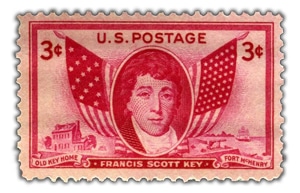“Oh, say can you see by the dawn’s early light
What so proudly we hailed at the twilight’s last gleaming?”
We Americans recognize those as the first lines of our National Anthem, “The Star-Spangled Banner,” but to the author of those words, Francis Scott Key, the question was real.
During the Battle of Baltimore in the War of 1812, the British bombarded Fort McHenry for 25 hours straight. When it was over, Key wondered if the flag, known as the Star-Spangled Banner, still flew over the fort.
The adventure for Key began on August 24, 1814, when the British took prisoner Dr. William Beanes. Key, is a well-known lawyer whose genealogy included an uncle with a law firm, was recruited to assist in the effort to have Beanes released.
On September 5, Key set out on an American flag-of-truce vessel with Col. John Skinner to meet the British flagship. The meeting went well, and Key and Skinner secured Beanes’s release. However, the three men weren’t allowed to return to Baltimore — until the bombardment of Fort McHenry was over. They waited in the American vessel behind the British fleet.
 On August 24, the British set fire to many buildings in Washington, D.C., and they then set their sights on Baltimore. On September 12, the British fleet approached Baltimore at North Point, where 4,500 troops came ashore and began the 11-mile march through Maryland to the city. As the troops marched, the British fleet moved into position and began to bombard the fort.
On August 24, the British set fire to many buildings in Washington, D.C., and they then set their sights on Baltimore. On September 12, the British fleet approached Baltimore at North Point, where 4,500 troops came ashore and began the 11-mile march through Maryland to the city. As the troops marched, the British fleet moved into position and began to bombard the fort.
The British bombed Fort McHenry for 25 hours, but the American defenders refused to surrender, which caused the fleet to withdraw. The British troops encountered resistance on their march, and when they reached Baltimore, they saw the city’s battlements — 15,000 American soldiers — and heard that the fleet had failed to take the fort.
When Key realized the bombing had stopped, he looked to the fort to see if the flag was still flying. It was, and he quickly wrote a poem that became “The Star-Spangled Banner.” The song became our national anthem on Mar. 3, 1931.
“Oh, say does that star-spangled banner yet wave
O’er the land of the free and the home of the brave?”
- New York in the Revolution and War of 1812 Military Records
- Virginia in the Revolution and War of 1812 Military Records
Read More:
- Through the Perilous Fight: Six Weeks That Saved the Nation (Steve Vogel)
- By the Dawn’s Early Light: The Story of the Star-Spangled Banner (Steven Kroll)
- Star-Spangled History (Battle of Baltimore)
- Francis Scott Key (National Monument and Historic Shrine Maryland)






